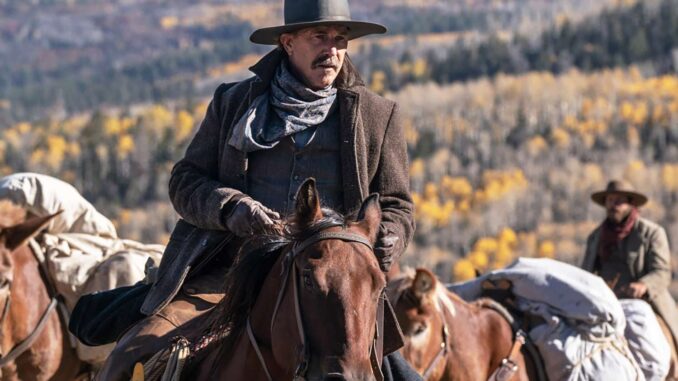
Kevin Costner made headlines when he stepped away from the wildly popular Yellowstone to embark on an ambitious project: a sprawling four-film saga exploring American Western expansion. However, the first installment, Horizon: An American Saga – Chapter 1, clocks in at over three hours and leaves many wondering if this was the right choice. Is this epic really worth your time? Let’s break it down.
A Long and Winding Journey
The Premise and Ambition
Horizon: An American Saga attempts to weave a complex narrative set against the backdrop of the American frontier. Starting in 1859 and spanning 15 years, Costner aims to humanize and deepen the story of Westward expansion. Sounds intriguing, right? Unfortunately, the execution falls flat.
While the idea of exploring the dark realities of manifest destiny is commendable, the film stumbles in its delivery. Instead of a gripping narrative, we’re met with a convoluted plot that struggles to keep viewers engaged. Costner and co-writer Jon Baird’s script often feels like it’s trying too hard to be profound, resulting in a muddled mess that lacks clarity and coherence.
Character Overload
With more than 20 named characters scattered throughout the film, the sheer number makes it challenging for viewers to invest emotionally. Characters pop in and out like they’re part of a sprawling ensemble drama, but without the depth or nuance needed to make their stories resonate.
Frances Kittredge, played by Sienna Miller, is one of the central figures. After surviving a massacre, her character seems remarkably unfazed. Within a short time, she’s smiling and flirting, leaving viewers scratching their heads at the tonal dissonance. If losing family members in a brutal attack doesn’t leave a mark, what will?
Visuals vs. Narrative: A Tale of Two Films
Stunning Scenery
One aspect that stands out is the film’s breathtaking cinematography. The natural landscapes are a feast for the eyes, capturing the rugged beauty of the American West. But while the visuals are compelling, they can’t save the film from its narrative shortcomings.
It’s like watching a stunning painting but struggling to understand the story behind it. Without a strong narrative to match the beautiful visuals, the film feels more like a series of pretty pictures strung together, lacking the emotional weight that great storytelling brings.
Soundtrack and Tone
Another significant miss comes from the film’s soundtrack. While it attempts to evoke the classic Western feel, John Debney’s score comes off as overly sentimental and intrusive. It lacks the haunting beauty of Ennio Morricone’s iconic compositions, which would have better suited the tone.
Instead, viewers are bombarded with a “sappy sledgehammer” soundtrack that detracts from the moments that should be impactful. When the music oversells the emotion, it makes the scenes feel forced and contrived.
Attempting to Address Complex Themes
The Dark Reality of Expansion
Costner aims to confront the darker side of manifest destiny—how it impacted Native Americans and the settlers alike. However, his approach often feels superficial. The film introduces Native American perspectives but does so in a way that lacks depth, making it hard for viewers to connect with their struggles.
For instance, a sequence showing the Apache attacking the town of Great Day is brutal but lacks the emotional context necessary to resonate with audiences. The film merely scratches the surface of these complex themes, missing an opportunity to provide a more nuanced exploration.
Humor or Misfire?
There are moments that aim for levity, but they often land flat. The dialogue can be unintentionally comical, leading to an experience that feels more like a parody than a serious narrative. Characters deliver lines that sound like they belong in a different genre entirely.
For example, after a massacre, one character reflects on the grave markers nearby, leading to a “witty” retort about building on the other side of the river. Instead of a poignant moment, it becomes a cringe-worthy attempt at humor that falls short.
The Ending: A Whiplash Inducing Montage
A Setup for Sequels
By the time the film reaches its conclusion, viewers are hit with a montage that feels more like a teaser for upcoming films rather than a satisfying resolution. The narrative jumps around wildly, leaving many questions unanswered. Instead of feeling like a cohesive first chapter, it resembles a collection of random scenes designed to drum up interest for the sequels.
This leaves audiences wondering: Is this just a ploy to drag out the story over multiple films? Costner himself appears to have invested significantly in this saga, but whether viewers will follow him on this journey remains to be seen.
Conclusion: A Disappointing Detour
In sum, Horizon: An American Saga – Chapter 1 is a bold but ultimately misguided endeavor. Kevin Costner’s departure from Yellowstone for this ambitious project raises eyebrows, especially given the film’s bloated runtime and lack of narrative clarity. While the visuals are stunning, the storytelling is cumbersome and fails to engage. If this is what the saga has to offer, audiences may hesitate to commit to the next three installments.
FAQs
Q: Is Horizon: An American Saga worth watching?
A: If you’re a fan of beautiful cinematography and classic Western themes, you might appreciate the visuals. However, if you’re looking for a coherent story and engaging characters, you might want to skip it.
